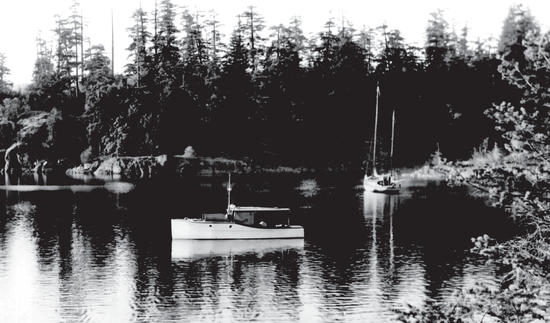Publisher’s Preface
by Howard White
Rereading this book after fifty-odd years, I was worried about what I might find. When I first read M. Wylie “Capi” Blanchet’s slightly fictionalized story of a single mother who sets out in a twenty-five-foot day cruiser, the Caprice, to explore the BC coast while accompanied by five young children and a dog, it was a watershed moment in my life. It was the 1960s, and I had grown up in the isolated bays and fishing villages of the kind Blanchet describes in The Curve of Time. My ambition, encouraged by my parents, was to apply myself to my correspondence lessons, get an education and escape from those godforsaken backwaters, never to return. I did eventually get the education, but it didn’t work out the way we planned. I am still living in a fishing village and have spent the ensuing decades lavishing the British Columbia raincoast with attention as a writer and book publisher. Reading The Curve of Time was key in changing my thinking about the rural West Coast from a bleak backwater to a place of wonder and a worthy subject of books.
Dipping into The Curve of Time again, I feared I would find it dated and diminished by the passage of years, as with so many books that inspired one’s youth. Instead I found Capi Blanchet’s sprightly tale has maintained all of its vigour and revealed a mastery of style and vision I’m not sure I fully appreciated before. It is one of those rare books that just gets better with passing years. There are books that describe the coast with greater geographical accuracy and greater historical insight, especially on Indigenous matters, but none that touch it at capturing the magic of the place. It still reads like a seaweedy blend of Robinson Crusoe and Peter Pan.

Capi Blanchet was an unlikely author and The Curve of Time was an unlikely candidate for lasting acclaim. Other commentators have made much of Capi’s prowess as a sailor, guiding her small, kid-laden shell of a boat through hazardous waters today’s yachters hesitate to enter in twin-diesel fifty-footers loaded with electronics. A case in point is her hair-raising account of her circumnavigation of Vancouver Island, which appears in book form for the first time in this edition. Other than a few times when her temperamental four-cylinder Kermath engine stalled, Capi never got into serious trouble. That is a miracle all of its own. But her achievement on paper was greater.
The Curve of Time was her only full-length book and she published it decades after the adventures that she describes with such immediacy and freshness. By the time the book finally appeared, in her seventieth year, the juvenile adventurers, through whose eyes much of the story’s excitement is conveyed, were middle-aged adults with children of their own. That she was able to reach back in memory and recreate not just the narrative outline of those long-past travels but the feeling they inspired, amplified through the words and actions of her five young children, is a feat that puts one in mind of her friend Hubert Evans, who revisited his childhood after eighty years in his novel O Time in Your Flight. But he was a master crafting his swan song after millions of published words, and she was an uncertain beginner. The more we learn, the more remarkable her book appears.
Little has come down to us about Capi’s creative practice, but the few glimpses we have suggest writing didn’t come easily to her. She worked on her one book for years, did much revision and sought the advice of the few other writers she knew. One was Evans, a widely published author of children’s stories and novels who also spent summers exploring the BC raincoast in a small gasboat loaded with kids and who occasionally travelled with the Blanchets. Evans told me that when he first saw Capi’s manuscript, it was entirely different from the finished 1961 version—a series of accounts of separate trips written in guidebook style, perhaps similar to her 1936 account of cruising up the west coast of Vancouver Island, which is included in this edition. Evans urged her to collapse the travels of some fifteen years into one continuous narrative and recast it in her natural storytelling voice. If indeed that was how the book evolved, she certainly mastered the approach. The Curve of Time flows along with a narrative momentum and a confident lightness that Evans himself might have envied.
M. Wylie “Capi” Blanchet was a remarkable woman in more ways than one, although the person behind the legend was somewhat at odds with the jolly scout master persona she assumes in her book, as contributions by her grandchildren and the journalist Edith Iglauer attest elsewhere in this edition. It all just adds to the wonder that is The Curve of Time.
Howard White
Madeira Park, 2024
